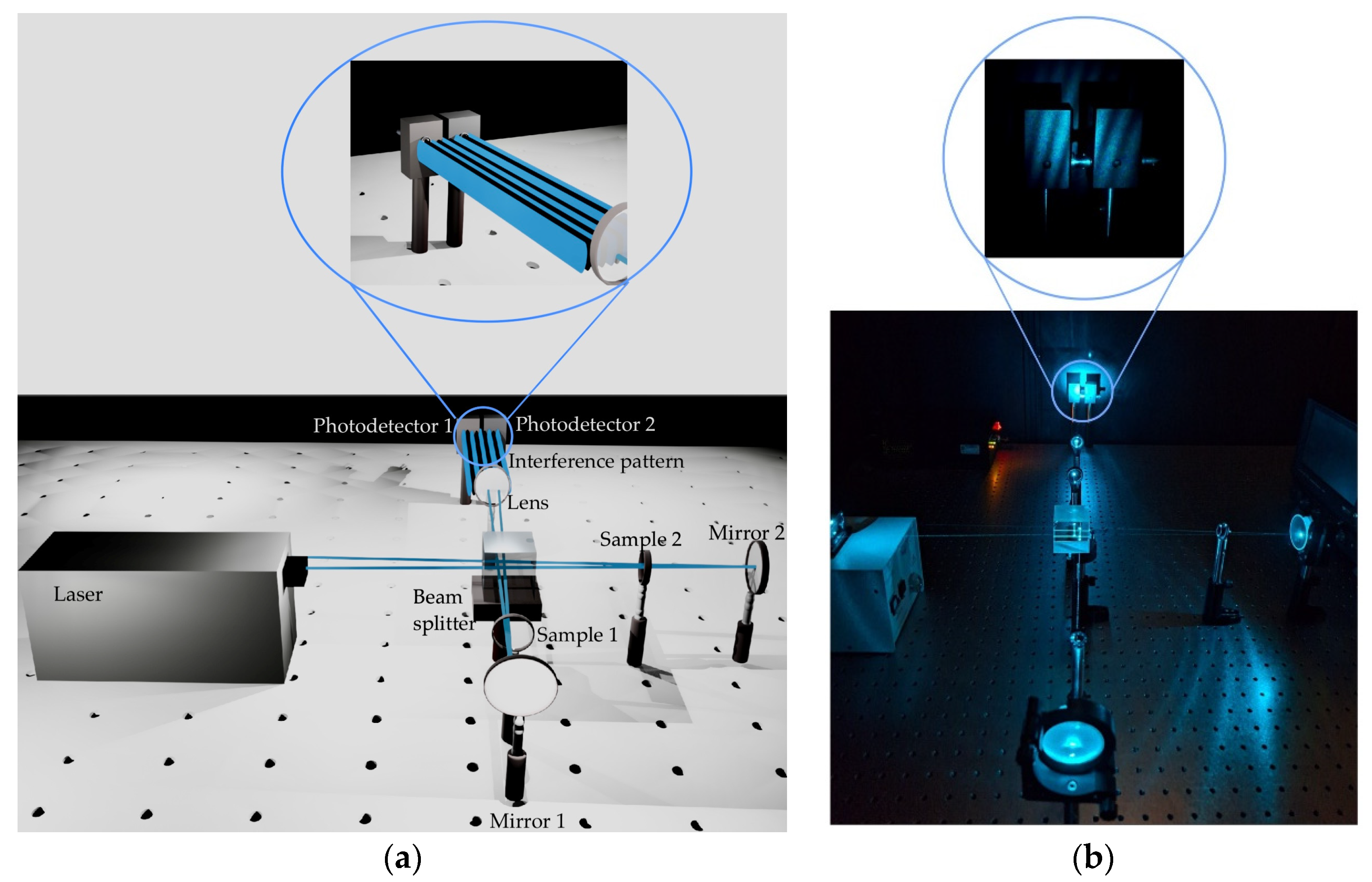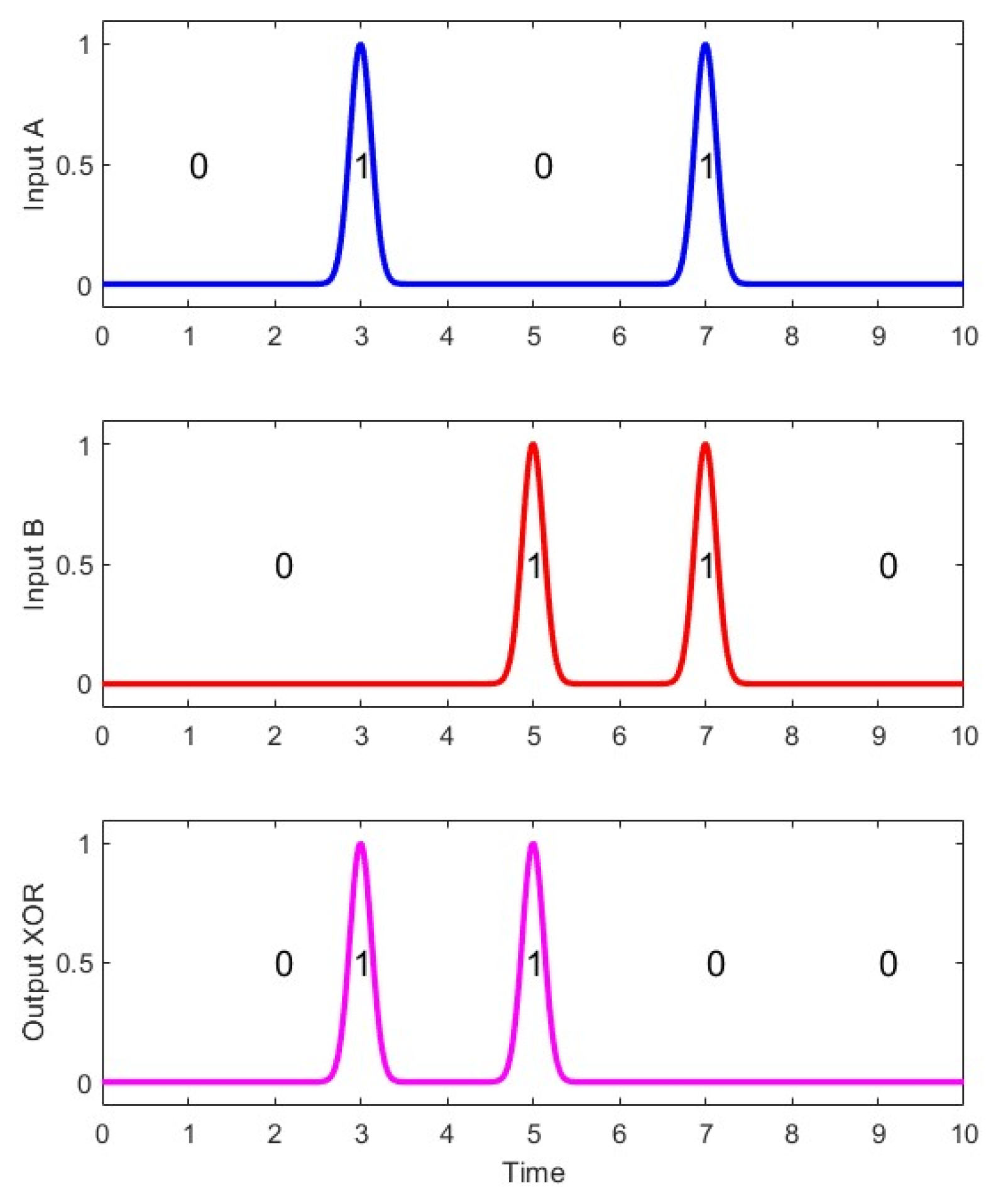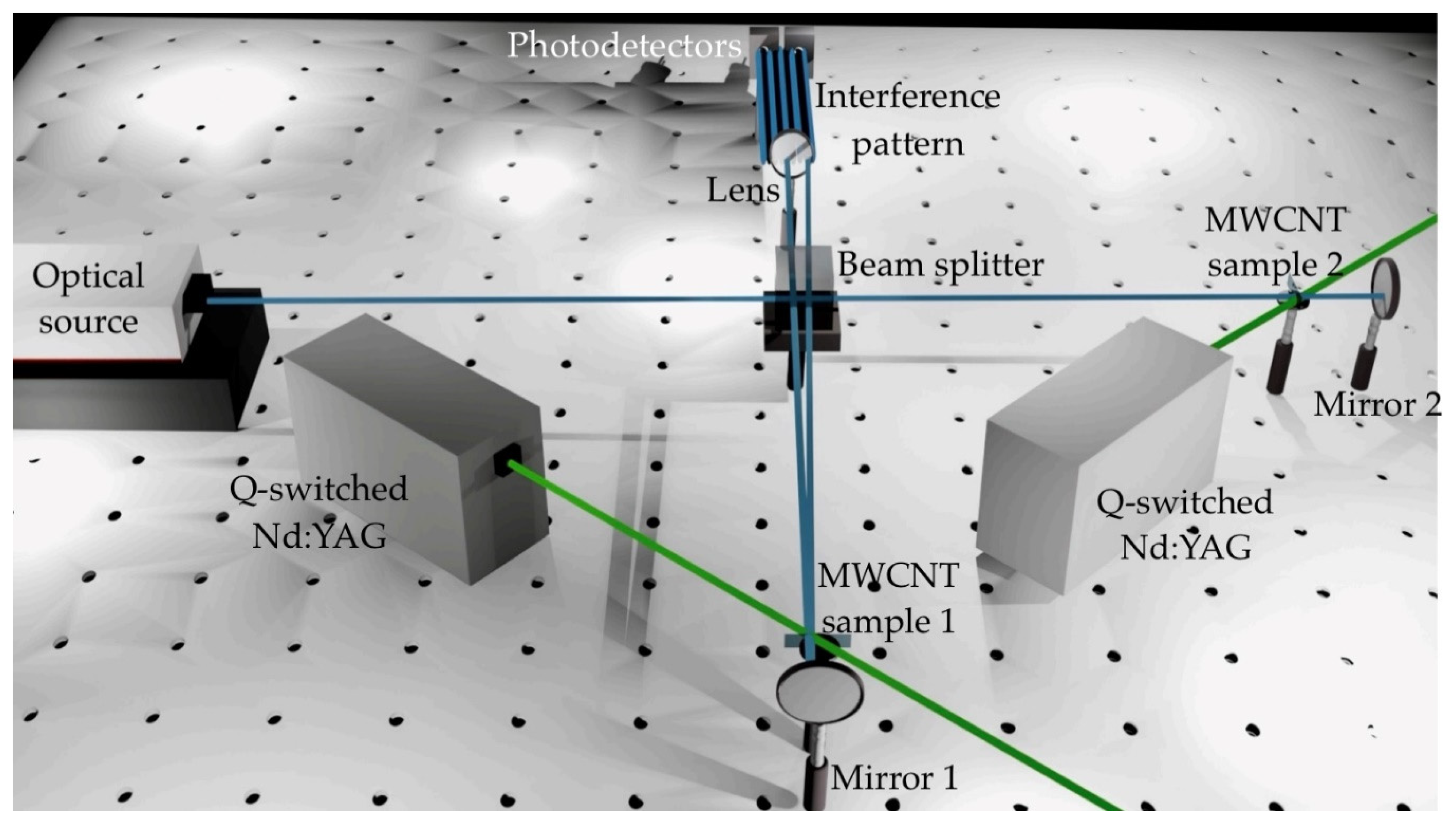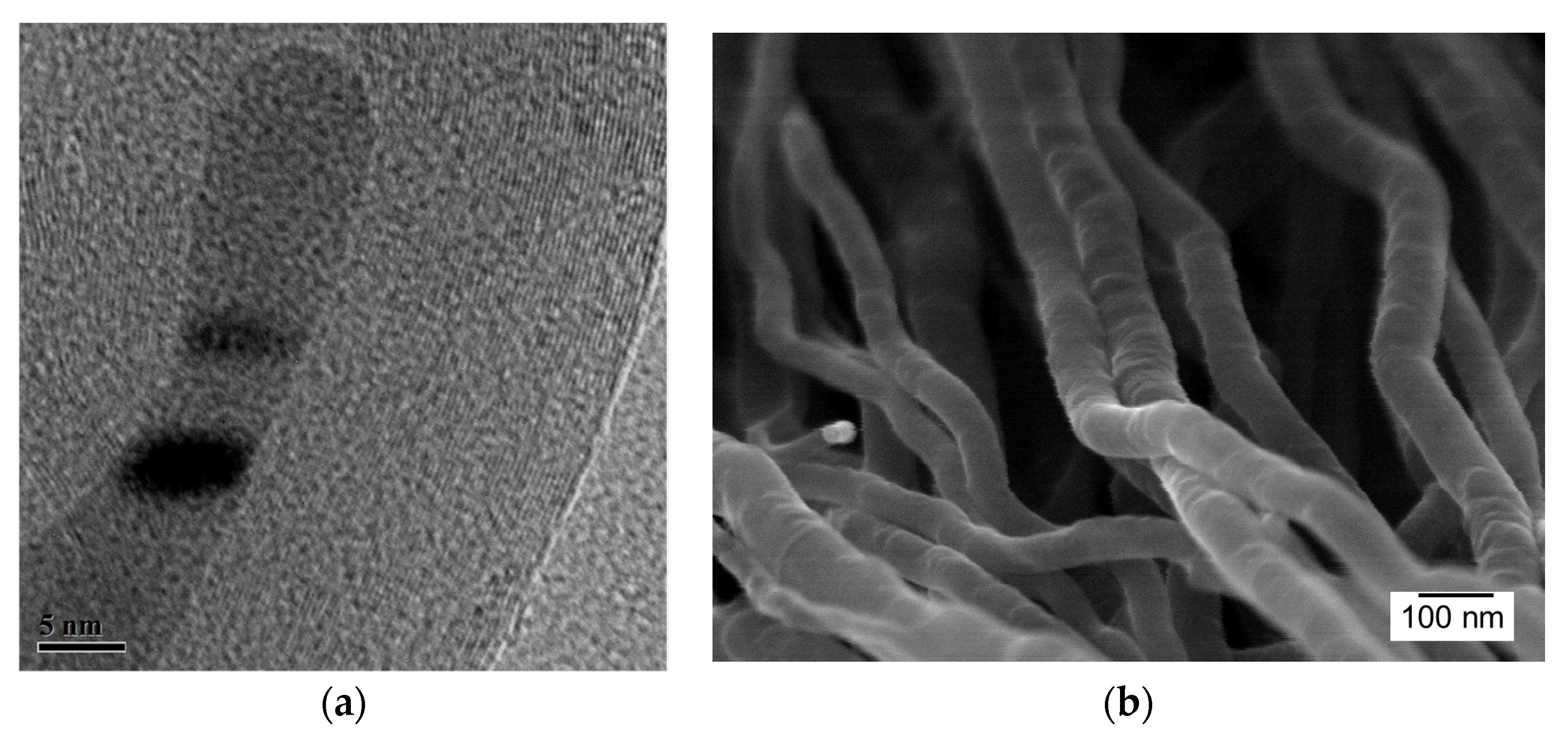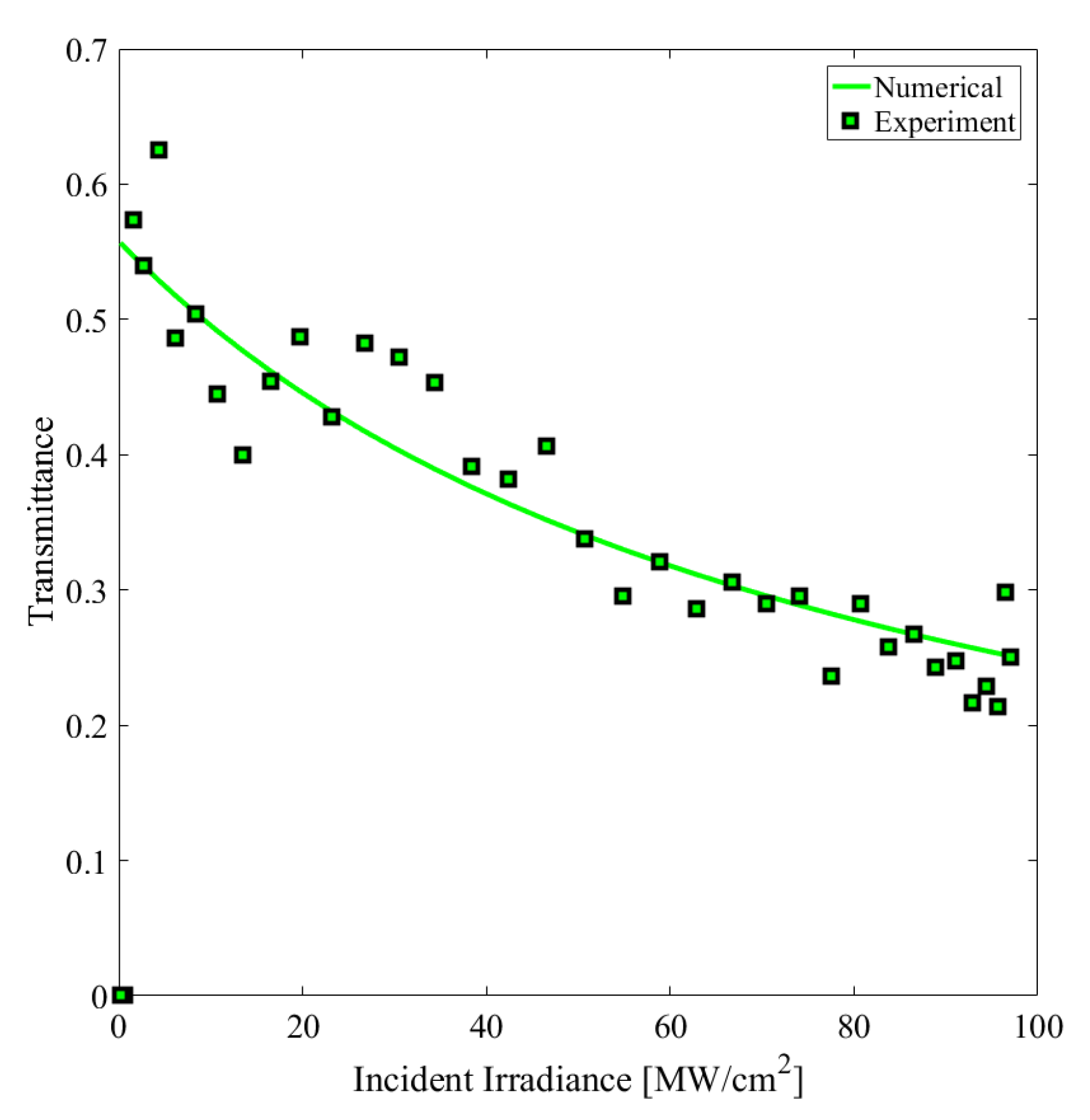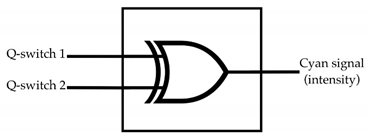1. Introduction
All-optical logic gates have emerged as a promising technology for next-generation information processing, offering potential advantages in speed, energy efficiency, and integration density compared to traditional electronic systems [
1]. The growing demand for more robust, effective, and reliable encryption systems has spurred research in this field, seeking to overcome the limitations of conventional electronic device-based systems [
2]. Among these, the exclusive-OR (XOR) gate plays a crucial role in many encryption algorithms, providing a fundamental building block for creating complex cryptographic functions [
3]. This work focuses on the development of purely optical XOR logic compounds for encryption applications. The growing demand for more robust, effective, and reliable encryption systems has spurred research in this field, seeking to overcome the limitations of conventional electronic device-based systems. The main motivation is to harness the inherent advantages of optics, such as ultrafast processing speed, parallelism, and enhanced security, to perform data encryption and decryption operations more efficiently. Recent advances in optical logic compounds encompass a variety of approaches: photon crystal-based composites that take advantage of interference and resonance effects [
4] have been implemented; plasmonic structures that allow the confinement of light at subwavelength scale [
5] have shown promise; and quantum dot optical semiconductor amplifiers (QD-SOAs) that offer faster responses, among other features, have been used in the realization of optical switching control [
6] or, in combination with optical filters, for the development of optical gates whose applications require different precision [
7]. Furthermore, reconfigurable compounds capable of performing multiple logical operations in parallel have been developed, as have more complex devices such as fully optical semiconductors, comparators, and combinational circuits [
8]. Current research focuses on integrating these technologies into photonic chips capable of performing multiple logical operations on a single platform, advancing towards the realization of more sophisticated and efficient optical computing systems.
In the field of optical encryption, various schemes have been developed that take advantage of the properties of light to protect information. Some techniques we can mention are phase modulation, coding in the spatial domain, and using interference patterns to encode data [
9]. These mainly include techniques using nonlinear effects. One of the most used nonlinear effects is the Kerr effect, which takes advantage of the nonlinearities present in different materials, although the use of this effect is also being explored for purely optical encryption with multilayers of nanomaterials, like multiwalled carbon nanotubes (MWCNT) [
10], or in graphene oxide decorated with Pt [
11]. Optical activity can even be used in conjunction with carbon-based nanofluids and plasmonic nanoparticles to obtain a kind of Kerr effect [
12]. However, the Kerr effect is not the only nonlinear effect used, as optical vortices can also be used to achieve ultrasecure encryption, given the high-precision characteristics provided by an optical vortex [
13]. It is important to mention that optical encryption through logical gates is a widely explored field and can be approached from different perspectives including different techniques and materials, as is the case in which metamaterials are used to assist with the necessary optical processes.
MWCNT were selected for this study due to their extraordinary property profile. First, MWCNT exhibit superlative mechanical properties [
14], including exceptional tensile strength (up to 63 GPa) and remarkable elasticity (Young’s modulus of about 1 TPa), making them ideal candidates for applications requiring robust and flexible materials [
15,
16]. Furthermore, a particularly advantageous feature of MWCNT is the possibility to tune their optical properties relatively easily by manipulating their morphology [
17]. This fine-tuning capability allows the optical responses of MWCNT to be tailored to specific needs, which is crucial in advanced photonics applications [
18,
19]. For instance, the band gap of MWCNT can be adjusted by controlling their diameter and chirality, allowing for the modulation of their optical absorption and emission properties [
20]. Also, MWCNT present nonlinear optical absorption that allows effects like self-phase modulation [
21]. The combination of these exceptional characteristics—superior mechanical strength and tunable optical versatility [
22]—makes MWCNT an ideal cutting-edge material for exploring new frontiers in the field of optical encryption.
While nonlinear optical effects have been widely explored for encryption purposes, it is important to note that linear optical effects also play a significant role in optical encryption techniques. One notable example is the encryption of hidden patterns in photonic crystals, which can only be revealed under specific stimuli. These systems leverage the unique properties of photonic crystals, such as their photonic band gaps and their ability to manipulate light propagation [
23]. In these encryption schemes, information is encoded into the structure of the photonic crystal itself, often through carefully designed defects or structural modifications. The encrypted information remains hidden under normal conditions but can be revealed when the photonic crystal is subjected to specific wavelengths, polarizations, or angles of incident light [
24]. This approach has been demonstrated in various configurations, including one-dimensional photonic crystals, where hidden images can be revealed by altering the incident angle of light [
25], and two-dimensional photonic crystal slabs, where encrypted patterns become visible under specific polarization conditions [
26]. The use of linear optical effects in photonic crystals for encryption offers advantages such as passive operation, high information density, and the potential for multilevel security through the combination of multiple encoding mechanisms [
27]. Also, recent advancements have further expanded the potential of linear optical effects in encryption, as demonstrated by the development of dual optical information-encrypted/decrypted invisible photonic patterns based on controlled wettability [
28].
The use of interferometry in this context is justified by its ability to generate and manipulate interference patterns with high precision. Interferometers, such as the Michelson interferometer used in this work, allow precise control of the phase and intensity of light, which is crucial for implementing logical operations in the optical domain [
29]. Interferometry also offers the advantage of being highly sensitive to small changes in the optical path length, refractive index, and polarization of light [
30]. These changes can be induced by various physical phenomena, including mechanical vibrations, temperature fluctuations, and pressure variations, making interferometry a versatile tool for sensing and measurement applications [
31]. In the context of encryption, this sensitivity can be exploited to create robust, hard-to-violate encryption systems, as even minute perturbations in the optical path can significantly alter the interference pattern and, consequently, the encoded information [
32].
Herein is presented an original optical arrangement that functions as an XOR optical logical gate controlled by an optic interference pattern and the nonlinear absorption exhibited by MWCNT, turning it into an all-optical gate function that is dependent on the light intensity. Using a Michelson interferometer and photodetectors, it is possible to implement the XOR operation directly in the optical domain, resulting in a higher processing speed compared to purely electronic implementations. The samples of MWCNT allow the control of the light intensity. Our key contributions include utilizing MWCNT’s nonlinear optical properties for light intensity control, implementing an interferometric setup for XOR operations directly in the optical domain, and developing a multicriteria decision analysis based on nonlinear optical absorption in MWCNT for enhanced encryption security. The experimental results demonstrate the feasibility and potential of the proposed optical arrangement, laying the foundations for the development of high-speed data encryption and processing systems based on optical principles. This approach opens new perspectives in the field of encryption and information security, with potential applications in secure communications, data storage, and high-performance computing such as quantum computing or biological computing.
2. Materials and Methods
2.1. Sample Preparation and Morphology Characterization
The preparation of MWCNT used in this experiment was carried out as follows: a nebulized mixture of carbon and catalyst material precursors (toluene and ferrocene, respectively) was injected continuously for 40 min into a quartz tube in a horizontal furnace at 850 °C using an Ar flow of carrier gas. At the end of this reaction time, the furnace was brought to room temperature, then the material was collected from the tube walls by scraping. The morphology and structure of the samples was analyzed by Transmission Electron Microscopy (TEM, FEI, Hillsboro, OR, USA, Titan 80-300, JEM-ARM200CF) and Scanning Electron Microscopy (SEM; SEM ULTRA 55 FEG System from ZEISS with Secondary Electron and Backscattering Detector, Jena, Germany).
2.2. XOR Encryption by Superposition of Optical Waves
The work implements an optical array based on a Michelson interferometer to develop an all-optical XOR gate as depicted in
Figure 1. The optical source corresponds to a cyan scientific laser (Laser model 14135, Spectra Physic, Milpitas, CA, USA), which is a compact solid-state frequency-doubled laser that provides stable 488 nm laser output at fixed power levels of 10 mW, and its spot size is 0.70 mm ± 0.05 mm. The interferometer is constructed using 50.8 mm diameter anodized aluminum mirrors (Flat Mirror, Zerodur M2, Newport, Irvine, CA, USA), arranged perpendicular to each other, and a beam splitter (BS, Newport, Irvine, CA, USA) positioned at 45° with respect to both mirrors. A sample located in a movable shutter is placed in front of each mirror to control the optical signal. The sample is integrated by MWCNT in thin-film form.
The footprint of the proposed all-optical XOR logic gate corresponds to an area of approximately 1 mm2 with a thickness of the MWCNT film of 400 μm deposited in a SiO2 substrate of 1 mm thickness in each arm of the interferometer. Nanoscale passive optical components can be employed to reach the minimal physical size of the logical gate employed in our experiments.
The resulting interference pattern can be projected onto a screen for the calibration, and a lens is used to amplify it and display it more clearly. The experimental method consists of generating an interference pattern using this interferometer. The laser beam is split in two beams that are reflected by the mirrors and recombined to create the interference pattern. A central intensity fringe of the pattern is recorded by two photodetectors, whose electrical response varies depending on the intensity of light received. The photodetectors are connected to a circuit to obtain the final output of the XOR gate. It is necessary to characterize the photodetectors to determine a threshold, from which any measurement above is considered as a “1” and any measurement below is considered “0”. This allows us to limit the logic response under various operating conditions.
The operation of the XOR gate is achieved by modulating the intensity of light reaching the photodetectors through the interference pattern and the MWCNT acting as shutters. The combination of the signals from the photodetectors in the adder circuit produces the final output of the XOR gate.
The XOR gate is a fundamental component in many encryption systems. Its operation is characterized by producing a true output (1) only when its inputs are different.
In the context of this research, inputs A and B correspond to the optical signals detected by the two photodetectors. A high level of light intensity (bright band) is interpreted as a logic 1, while a low level (dark band) is interpreted as a logic 0. The adder circuit combines these signals to produce the XOR output according to the truth table. This optical implementation of the XOR gate allows logical operations to be performed at ultrafast speeds, taking advantage of the properties of light for information processing and data encryption. In
Figure 2, the performance of the XOR logic gate is schematized.
The interferometer was tested in multiple configurations, changing the distance between the components to ensure the repeatability of the system, and a Matlab program R2016a was employed to analyze the size of the fringes of the generated interference pattern, allowing accurate characterization of the optical system.
The two photodetectors that represent the inputs of the XOR gate are positioned to coincide with the dark fringes of the interference pattern as it formed. When the interferometer is operating and the full interference pattern is generated, the dark fringes fall directly on the photodetectors. This absence of light results in a low electrical response of the photodetectors, which is interpreted as a logical “0” in the context of the XOR gate. To generate a logic “1”, the MWCNT sample under irradiation is used to block one of the arms of the interferometer and the fringes of interference disappear. The nonlinear optical absorption of the sample under an irradiance provided by a neodymium–yttrium garnet (Nd:YAG) (Continuum SL II-10, Cambridge, MA, USA) laser that generates 532 nm individual pulses that last 4 nanoseconds with energy of 10 mJ and spot size of 0.1 mm ± 0.01 mm interrupts the interference pattern, allowing a high response that is interpreted as a logical “1”. This design, shown in
Figure 3, allows the XOR gate functionality to be implemented purely optically. When both arms of the interferometer are open in absence of the pump beam given by the Nd:YAG laser system in the samples, the interference pattern is formed and both photodetectors receive little light, resulting in a 0 output. When one arm of the interferometer is blocked, one of the photodetectors receives direct light while the other remains in darkness, resulting in an output of 1. When both arms are blocked, both photodetectors receive direct light, resulting in an output of 0. This approach takes advantage of the unique properties of light and optical interference to perform logic operations at potentially much higher speeds than implementations in conventional electronic technologies, opening new possibilities in the field of encryption and high-speed data processing.
2.3. Nanosecond Transmittance in MWCNT
To examine the nonlinear optical behavior of the samples, researchers used single-beam tests to look for any nonlinear optical absorption in the samples after they were subjected to these nanosecond pulses.
One can use mathematics to represent light transmission through a material that exhibits nonlinear optical absorption [
33].
Equation (1) is the equation for the transmitted irradiance, I, as it relates to the propagation distance L and the initial irradiance I0.
The optical absorption coefficient at low light intensities is denoted by
α0 in Equation (2), the nonlinear optical absorption coefficient by
β, and the material’s effective length by
Leff [
33].
These equations give a foundation for understanding how the material’s optical characteristics change under varied light intensity and propagation distances.
2.4. Multicriteria Decision Analysis by Nonlinear Optical Absorption
The measurement of the nonlinear optical absorption in MWCNT is proposed for developing a multicriteria decision function in an XOR encryption system. This technique is based on the inspection of the irradiance in propagation through the samples in thin-film form located in place of the detectors of the interferometric system.
We consider an XOR operation that generates a logical one if the incident beams are assumed to be different for both detectors; otherwise, a zero value is obtained as a logical output. In this work, the operation principle underlying this function was proposed to be a measurement of transmittance. The nonlinear transmittance in the nanotubes depends on an irradiance that promotes a multiphotonic effect with the potential of switching the threshold related to the binary data recorded in the samples.
The encryption method is then dependent on the irradiance inducing a selectable nonlinear optical absorption in the MWCNT. The decryption stage was proposed by the recording of the nonlinear optical transmittance. It is worth noting that this nonlinear optical absorption in the XOR encryption can be considered unbreakable without the knowledge of the influence of the optical nonlinearities in the two signals involved in the logic system. In
Figure 4, the experimental setup for encryption with the assistance of interference and multiphotonic processes induced in MWCNT by nanosecond pulses is presented.
3. Results
Figure 5a shows a typical bright field TEM image of the MWCNT samples. The multilayered nature of the nanotubes is confirmed by this photograph. On the other hand,
Figure 5b shows an isolated single carbon nanotube captured by SEM.
The TEM and SEM images presented in
Figure 5 are crucial for understanding the specific nanostructure of the MWCNT used in this study. The nanoscale dimensions of these structures are directly linked to their nonlinear optical performance, which is central to our encryption method. At the nanometer scale, MWCNT exhibit significant nonlinear optical effects that are almost imperceptible at larger scales [
34]. For instance, the multiwalled structure visible in the TEM image (
Figure 5a) contributes to the enhanced nonlinear response due to the increased electron confinement and interaction between the concentric tubes [
35]. Similarly, the SEM image (
Figure 5b) confirms the high aspect ratio of individual nanotubes, which is essential for their anisotropic optical properties and the resulting nonlinear effects [
36]. These nanoscale characteristics are fundamental to the observed nonlinear optical absorption and, consequently, to the performance of our optical XOR gate. In contrast, similar carbon structures at the microscale would not exhibit these pronounced nonlinear effects, making them unsuitable for our application in optical encryption.
We carried out an input–output experiment to look at the MWCNT samples’ nonlinear optical absorption characteristics. This involved changing the optical irradiance and monitoring the response of the samples.
Figure 6 displays the numerical and experimental data. After fitting the experimental data with Equation (1), the nonlinear optical absorption coefficient (
β) is estimated to be roughly 2.9 × 10
−9 m/W.
The samples’ ablation threshold was recorded by single pulses and results at 110 mJ/cm2. The experiments far from optical damage demonstrate the feasibility and effectiveness of the proposed optical arrangement to implement an XOR gate. Three different configurations of the Michelson interferometer were made to test the repeatability of the system, varying the distances between the components.
In each configuration, consistent interference patterns were generated, and the thickness of the fringes was measured using a program developed in Matlab.
The coherence length was measured, which is the maximum distance that one of the mirrors can be moved away before the interference pattern is lost. In this case, the coherence length is 96.52 cm ± 5%.
In the generation of the interference pattern, that is, in the optical path, considering the components we have, we can consider an error of ±1.030%.
The characterization of the photodetectors using the IV curve method revealed a behavior consistent with changes in the incident light intensity.
The operation of the optical XOR gate was verified using these thresholds, demonstrating that the system responds correctly to the different input combinations according to the truth table of an XOR gate. Additionally, the coherence length of the system was measured, resulting in 96.52 cm ± 5%, indicating a suitable operating range for the interferometer.
MWCNT function as a shutter controlled by nonlinear optical absorption induced by the Nd:YAG laser, such that when they are being irradiated only by the probe laser, the threshold of “1” is set, which is equal to an open mechanical shutter, while when the pump laser crosses the sample in the same place where the probe laser hits, it goes to the equivalent of a closed mechanical shutter, marking the threshold as “0”.
In turn, this allows us to determine that the transmitted irradiance drops by around 10%.
The variation in the incident irradiance of the Nd:YAG system is around ±2%; however, the effect of the change in the digital signal follows a third-order nonlinear optical behavior, so the error bar related to the influence of the incident irradiance over the output signal can be expected to be around ±8%. Reproducibility of the output data was guaranteed by approximately one hundred measurements under comparative laboratory conditions with a confidence level close to 90%.
4. Discussion
Optical gates designed with interferometers are a fundamental technology in the field of photonics. There are three main types of interferometers used in these gates: Sagnac, Michaelson, and Mach–Zehnder. While this work utilizes a Michelson interferometer, it is important to acknowledge the relative merits of other interferometric configurations, particularly the Mach–Zehnder interferometer (MZI). The MZI offers significant advantages in terms of compactness, especially when implemented in integrated optical circuits [
37]. Their planar geometry makes them highly suitable for on-chip applications, allowing for more efficient miniaturization of optical systems [
38]. In terms of power consumption, the MZI exhibits particular potential when used in electro-optic modulators, where they are widely recognized as the best-performing interferometers [
39]. The MZI’s ability to operate with lower optical powers while maintaining high sensitivity makes it an attractive choice for low-power optical computing and encryption applications [
40]. Furthermore, in the context of miniaturized optical circuits, the MZI provides better stability and easier integration compared to Michelson interferometers [
41]. While our current setup employs a Michelson interferometer due to its simplicity and ease of alignment in bulk optics configurations, future iterations of this work could benefit from transitioning to MZI-based designs, especially when considering on-chip implementations for more compact and efficient optical encryption systems.
The Michelson interferometer is used for its simple and versatile configuration, which allows precise control of the optical path difference. Its high stability and ability to maintain a constant phase difference are crucial for generating reliable interference patterns. The interferometer’s wide dynamic range allows it to handle a range of light intensities while maintaining clear interference patterns. Its fast modulation capability is essential for performing high-speed encryption and decryption operations.
It is important to consider the temporal characteristics of these gates. It is important to clarify our use of terms like “ultrafast” in the context of this work. While we acknowledge that the overall system speed is limited by the nanosecond regime of our laser source, potentially constraining applications to frequencies below 1 GHz, our reference to “ultrafast” processes specifically pertains to the intrinsic response of the MWCNT themselves. Multiple studies have reported femtosecond-scale response times for the nonlinear optical effects in MWCNT [
42,
43]. For instance, Ma et al. [
44] demonstrated that MWCNT exhibit an ultrafast optical Kerr effect response time of approximately 1 ps. Similarly, Wang et al. [
45] reported sub-picosecond recovery times for saturable absorption in MWCNT. These ultrafast responses are indeed electronic in nature, primarily due to the rapid thermalization of hot electrons within the conduction band of the nanotubes [
46]. While our current experimental setup does not fully exploit this femtosecond-scale potential due to limitations in our laser source and detection system, the intrinsic capabilities of MWCNT for ultrafast optical switching remain a key motivation for their use in our work and highlight their potential for future high-speed optical logic applications.
Recent advances in materials with nonlinear optical properties are opening new possibilities in the field of encryption. These materials, such as MOFs (metal–organic frameworks) [
47], overcome the limitations of conventional encryption systems. Experiments using 400-nanometer lasers have achieved processing speeds of one terahertz, marking a significant milestone in encryption speed [
48]. The most advanced technologies in this field include the use of metamaterials and femtosecond pulses, which allow the implementation of secure and effective quantum encryption schemes.
However, it is important to note that the use of nonlinear materials for optical effects such as the Kerr effect implies higher power consumption in the system, which represents a challenge in terms of energy efficiency. While the more energetic 488 nm wavelength might help address this issue, it could also introduce new power considerations that require careful balance.
While our initial focus was on the nonlinear absorption in MWCNT under nanosecond laser irradiation, it is crucial to acknowledge that the overall nonlinear optical response is more complex and includes nonlinear refraction as well. In the context of interferometry, where the phase of light plays a critical role, the change in refractive index due to nonlinear effects becomes particularly significant. The nonlinear refractive index, often denoted as n
2, contributes to self-phase modulation and cross-phase modulation, which can significantly alter the interference patterns [
49]. In MWCNT, both nonlinear absorption and nonlinear refraction are present and can be described by the complex third-order susceptibility χ
(3) = χ
(3)′ + iχ
(3)″, where the real part χ
(3)′ is related to nonlinear refraction and the imaginary part χ
(3)″ to nonlinear absorption [
50]. The interplay between these effects can lead to a rich variety of phenomena, including intensity-dependent phase shifts and spectral broadening [
51]. In our experimental setup, while we primarily measured changes in transmitted intensity, the observed effects likely result from a combination of nonlinear absorption and refraction. Future studies should aim to decouple these effects, possibly through techniques such as Z-scan measurements or pump–probe spectroscopy, to provide a more complete picture of the nonlinear optical response of MWCNT in this encryption system [
52].
In the context of encryption, tests performed with various protocols have shown that there is no significant signal degradation during the encryption and decryption processes using an optical XOR gate. This underlines the potential of these gates in information security systems [
52]. The proposed system, leveraging the unique properties of the 488 nm laser and the Michelson interferometer, not only offers advantages in terms of speed but also security against cyber-attacks.
Our group has previously studied an XOR logic gate with the photoconductivity of MWCNT used in the detection of an interferometric pattern [
2]. In this work, we employed the nonlinear optical response of MWCNT to control the input signals of an all-optical XOR logic gate function.
This integrated approach has significant implications for future applications in long-distance secure communication systems as well as the integration of optical XOR gates into more complex information processing systems. This system has the potential to push the boundaries of optical computing and encryption by combining the advantages of different interferometer types, leveraging the benefits of shorter wavelengths, and exploring advanced materials. It has the potential to revolutionize the fields of information security and high-speed data processing.
This approach offers several advantages, such as phase-insensitivity, fiber compatibility, and the potential for integration. The devices operate based on the power-induced changes in the field amplitude, which are then transformed into useful power transmission systems through transverse modal coupling efficiency. This method demonstrates the versatility of nonlinear optical effects in creating complex logic operations and highlights the potential for developing fast, integrated, and robust all-optical signal processing devices.
